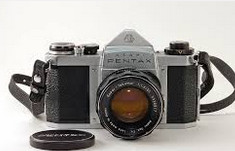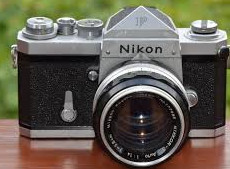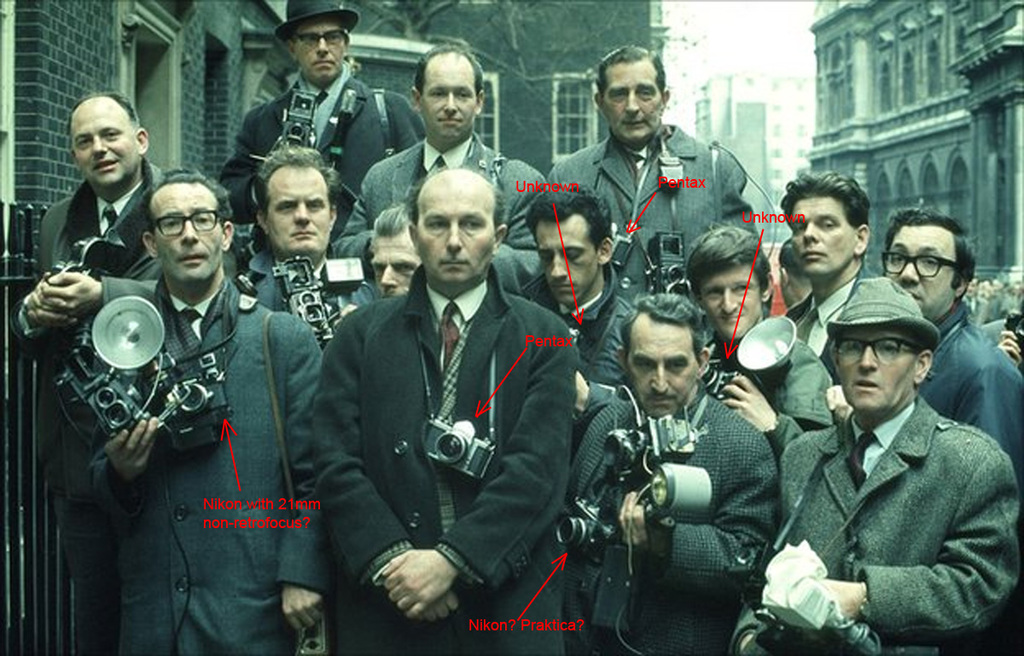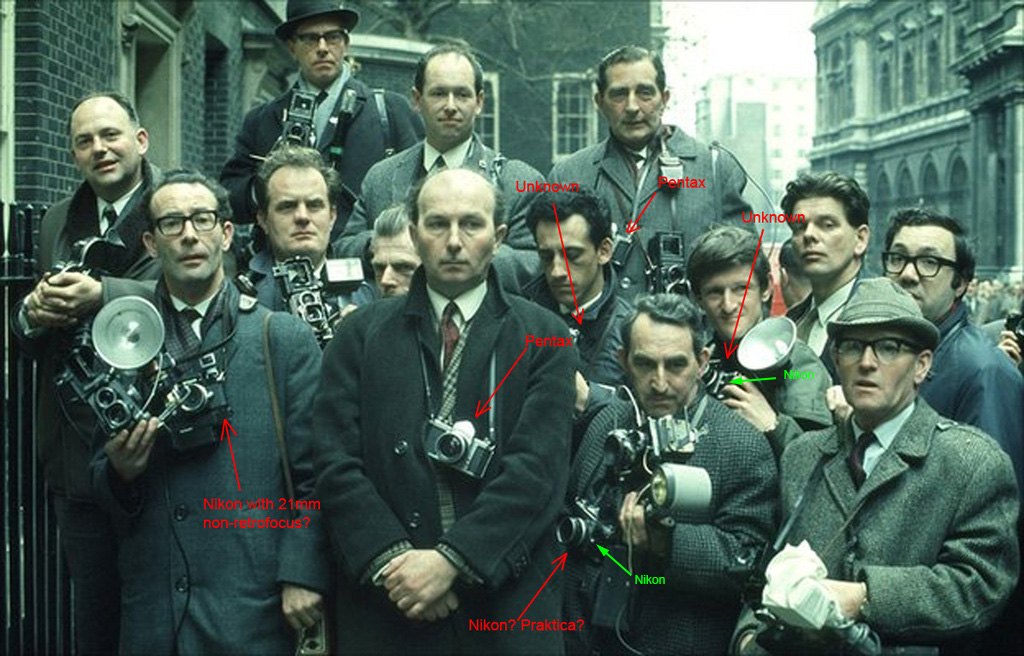| View previous topic :: View next topic |
| Author |
Message |
Gerald


Joined: 25 Mar 2014
Posts: 1196
Location: Brazil
|
 Posted: Wed Oct 08, 2014 3:00 pm Post subject: Posted: Wed Oct 08, 2014 3:00 pm Post subject: |
 |
|
Gerald wrote:
| peterqd wrote: |
I'm like Michael, in that I'm listening quietly and don't have much to add of any value. Except that so far the effect of fashion has been
overlooked. It became fashionable for pro-photographers to have a Nikon hung on their shoulder, not necessarily because it was "the
best", but simply because they didn't want feel they were out of the loop. So, although the ad may not be untruthful about the numbers
using Nikon, it says nothing about quality. |
The "theory" that Nikon became the professional camera of choice in the '60s and '70s because Nikon camera was fashionable for the pros is interesting, but incorrect in my opinion.
If there were some fashionable professional cameras in the '50s, they were the Leica and Zeiss. Nikon was the underdog! The reasons for Nikon have surpassed Leica and Zeiss were multiple and complex, but certainly the reliability of the cameras and the optical quality of the Nikon lenses played a very important role. Another important factor was the enormous flexibility of the Nikon system. I would say Nikon was for the professional 35mm format what Hasselblad was for medium format.
Today one can say that Nikon is a truly fashionable camera because of the million cameras Nikon sells every year to amateurs. However, until the mid-60s, Nikon only produced the professional model Nikon F. Only in 1965 Nikon launched the Nikkormat FT, which was more "amateurish" than the Nikon F, but to be more exact, the Nikkormat FT was a semi-professional camera. With the Nikkormat series, and after that, with the FM, FE, etc, Nikon started to become a very popular brand also among amateurs, too.
_________________
If raindrops were perfect lenses, the rainbow did not exist.
Last edited by Gerald on Wed Oct 08, 2014 3:29 pm; edited 1 time in total |
|
| Back to top |
|
 |
calvin83


Joined: 12 Apr 2009
Posts: 7555
Location: Hong Kong
|
 Posted: Wed Oct 08, 2014 3:29 pm Post subject: Posted: Wed Oct 08, 2014 3:29 pm Post subject: |
 |
|
calvin83 wrote:
| Gerald wrote: |
| calvin83 wrote: |
| FYI: The Carl Zeiss Ultron is deigned by Voigtlander(Patent US3612663). Zeiss put the name on it after they competely take over Voigtlander . |
Briefly, long ago Zeiss got used to put its own name on products made by other companies. Today, most Zeiss lenses are made by Cosina in Japan. Nonetheless, if "mother" Zeiss "adopted" the Ultron as its "daughter", the Zeiss Ultron is a Zeiss!
What I wanted to highlight was that the Zeiss Ultron 1968 had a similar design to a Nikkor lens from 1959. If some people consider that the design of the 1959 Nikkor 50mm F2 is a proof that Nikon had difficulty in designing a 50mm lens in 1959, why don't they explain why Voigtlander copied in 1968 a Nikon design from 1959? |
I think I don't need to comment on the first part.
For the second part, I would say it is unreasonable to say Voigtlander copied a mediocre lens and make it an excellent lens.
For those people who want to dig more on lens design:
Nikkon design the Nikkor-N 1.1/5cm for Nikon RF in the middle of 1950s ( Patent US2828671 ). If you look at the citation at the bottom, there is a citation to a Gemany patent DE 565566 C . You can see the design of the Nikkor-N 1.1/5cm is related to the design by Dr. Tronnier listed in DE 565566 C when he was working on Schneider in the early 1930s.
_________________
https://lensfever.com/
https://www.instagram.com/_lens_fever/
The best lens is the one you have with you. |
|
| Back to top |
|
 |
dan_


Joined: 05 Dec 2012
Posts: 1055
Location: Romania
Expire: 2016-12-19
|
 Posted: Wed Oct 08, 2014 5:24 pm Post subject: Posted: Wed Oct 08, 2014 5:24 pm Post subject: |
 |
|
dan_ wrote:
| Gerald wrote: |
| ... The reasons for Nikon have surpassed Leica and Zeiss were multiple and complex,... |
Did they? How? Financially? In image IQ? As symbols of the HQ photographic gear?
Leica has never been a financial leader in camera gear production. They never intended to be, as they were elitist targeting a small but devoted part of the market.
On the other hand Zeiss was, historically, one of the worse companies from the financial management point of view. It is sad to be the only company in history that succeeded, once between the world wars, to compete itself on the photographic market. What kept Zeiss alive through the ages were the medical, survey and military optical production and some important government contracts, not the photographic lenses.
So yes, financially Nikon has surpassed Leica and Zeiss, but that doesn't reflect in any way the difference in quality of the lenses the 3 companies produced. Many other companies have financially surpassed Leica and Zeiss.
From the IQ point of view even today the best Leica and Zeiss lenses are landmarks that easily surpass the best CaNikon.
They still are the symbols for excellence in the photographic lenses production, as they have always been. |
|
| Back to top |
|
 |
Gerald


Joined: 25 Mar 2014
Posts: 1196
Location: Brazil
|
 Posted: Wed Oct 08, 2014 5:35 pm Post subject: Posted: Wed Oct 08, 2014 5:35 pm Post subject: |
 |
|
Gerald wrote:
| dan_ wrote: |
| Gerald wrote: |
| ... The reasons for Nikon have surpassed Leica and Zeiss were multiple and complex,... |
Did they? How? Financially? In image IQ? As symbols of the HQ photographic gear? |
Of course I was talking about the market for professional 35mm cameras and lenses.
_________________
If raindrops were perfect lenses, the rainbow did not exist. |
|
| Back to top |
|
 |
dan_


Joined: 05 Dec 2012
Posts: 1055
Location: Romania
Expire: 2016-12-19
|
 Posted: Wed Oct 08, 2014 6:46 pm Post subject: Posted: Wed Oct 08, 2014 6:46 pm Post subject: |
 |
|
dan_ wrote:
Leica didn't target the average 35mm professional photographer market. Their expensive gear only targeted the rich professional photographers market, a small part of the whole market. And they hardly had any competition on their target market.
In the '50s-'60s' the 35mm professional photographer market was still young and the larger formats were still preferred. Zeiss, making lenses for Hassy and Linhof, was more interested in the medium/large format professional photographer market than in the professional 35mm market.
As an old Dinosaur-company, its response to market changes was not so quick.
IMO what happened in '50s -'60s when Nikon managed to impose on the 35mm. professional photographer market is quite similar with what's happening now on the mirrorless market when a company like Sony manages to impose on the market because CaNikon moves too slow. But that doesn't mean that Sony lenses/cameras are better than CaNikon. They are only in a better accordance with the market changes. |
|
| Back to top |
|
 |
memetph

Joined: 01 Dec 2013
Posts: 940
Location: Poland
|
 Posted: Wed Oct 08, 2014 7:11 pm Post subject: Posted: Wed Oct 08, 2014 7:11 pm Post subject: |
 |
|
memetph wrote:
| Gerald wrote: |
| calvin83 wrote: |
| FYI: The Carl Zeiss Ultron is deigned by Voigtlander(Patent US3612663). Zeiss put the name on it after they competely take over Voigtlander . |
Briefly, long ago Zeiss got used to put its own name on products made by other companies. Today, most Zeiss lenses are made by Cosina in Japan. Nonetheless, if "mother" Zeiss "adopted" the Ultron as its "daughter", the Zeiss Ultron is a Zeiss!
What I wanted to highlight was that the Zeiss Ultron 1968 had a similar design to a Nikkor lens from 1959. If some people consider that the design of the 1959 Nikkor 50mm F2 is a proof that Nikon had difficulty in designing a 50mm lens in 1959, why don't they explain why Voigtlander copied in 1968 a Nikon design from 1959? |
Are you sure ? The Zeiss Voigtlaender Icarex Ultron has a concave front element. The Rollei Planar HFT ( Voiglaender Ultron) has a slightly convexe front element . It seems it is the case of this Nikon S too.
When you say that the Ultron Icarex was copied from the Nokkor S , it is because you know it or is it what you guess? |
|
| Back to top |
|
 |
Gerald


Joined: 25 Mar 2014
Posts: 1196
Location: Brazil
|
 Posted: Wed Oct 08, 2014 8:00 pm Post subject: Posted: Wed Oct 08, 2014 8:00 pm Post subject: |
 |
|
Gerald wrote:
| memetph wrote: |
| Gerald wrote: |
| calvin83 wrote: |
| FYI: The Carl Zeiss Ultron is deigned by Voigtlander(Patent US3612663). Zeiss put the name on it after they competely take over Voigtlander . |
Briefly, long ago Zeiss got used to put its own name on products made by other companies. Today, most Zeiss lenses are made by Cosina in Japan. Nonetheless, if "mother" Zeiss "adopted" the Ultron as its "daughter", the Zeiss Ultron is a Zeiss!
What I wanted to highlight was that the Zeiss Ultron 1968 had a similar design to a Nikkor lens from 1959. If some people consider that the design of the 1959 Nikkor 50mm F2 is a proof that Nikon had difficulty in designing a 50mm lens in 1959, why don't they explain why Voigtlander copied in 1968 a Nikon design from 1959? |
Are you sure ? The Zeiss Voigtlaender Icarex Ultron has a concave front element. The Rollei Planar HFT ( Voiglaender Ultron) has a slightly convexe front element . It seems it is the case of this Nikon S too.
When you say that the Ultron Icarex was copied from the Nokkor S , it is because you know it or is it what you guess? |
Of course when I said that Voigtlander copied the Nikkor 50mm F2 lens, it was a figure of speech. The prominent feature of the Nikkor is having a negative element in front. This is exactly what the Voigtlander used in the Ultron. By the way, if the front lens is concave or convex, this is not the most important. What really matters is that the front lens has a negative power.
_________________
If raindrops were perfect lenses, the rainbow did not exist. |
|
| Back to top |
|
 |
Gerald


Joined: 25 Mar 2014
Posts: 1196
Location: Brazil
|
 Posted: Wed Oct 08, 2014 8:18 pm Post subject: Posted: Wed Oct 08, 2014 8:18 pm Post subject: |
 |
|
Gerald wrote:
| dan_ wrote: |
| Leica didn't target the average 35mm professional photographer market. Their expensive gear only targeted the rich professional photographers market, a small part of the whole market. And they hardly had any competition on their target market. |
Today Leica is niche camera but it was not so in the '50s and '60s. Between 1958 and 1967, Leica produced nearly 100,000 cameras. This is a very significant number for that time.
Leica was a competitive company and their prices were not ridiculously high as they are today. The 1960 price list below shows, for example, that a Leica M3 body cost only 10% higher than a Nikon SP body.
Contax IIa w/f/2.0 Sonnar - $248
Contax IIa w/f/1.5 Sonnar - $268
Contax IIIa - add $20
Separately, the f/2.0 and f/1.5 Sonnars were $119 and $139, respectively
Leica M3 - $270 body only, $399 w/f/2.0 Summicron, $468 w/f/1.4 Summilux
Leica IIIG - $163 body only, $292.50 w/f/2.0 Summicron
Exakta VXIIA - $230 body only w/metered pentaprism finder, $429.50 w/f/2.0 Biotar
Canon VI - $209.50 body only w/Canometer, $319.50 w/f/1.8 Canon, $419.50 w/f/1.2 Canon
Canonflex - $170 body only, $299.95 w/f/1.8 Super-Canomatic
Nikon SP - $245 body only, $329.50 w/f/2.0 Nikkor, $375 w/f/1.4 Nikkor, $544.50 w/f/1.1 Nikkor
Nikon F - $329.50 w/standard eyelevel finder & f/2.0 Nikkor
Kodak Retina IIIC (big C) - $175 w/f/2.0 Xenon
Argus C3 - $55.95 w/case & flash
http://photo.net/leica-rangefinders-forum/00acmo
_________________
If raindrops were perfect lenses, the rainbow did not exist. |
|
| Back to top |
|
 |
Jvg


Joined: 07 Nov 2012
Posts: 205
Location: New York City
|
 Posted: Thu Oct 09, 2014 1:58 pm Post subject: Posted: Thu Oct 09, 2014 1:58 pm Post subject: |
 |
|
Jvg wrote:
| iangreenhalgh1 wrote: |
| The Contax lenses were manufactured in Germany, later some of the models were produced in Japan by Tomioka to Zeiss standards, some models were always produced in Germany. |
Dunno, but my recent acquisition: Contax MIJ Carl Zeiss Planar T* 50/1.4 doesn't feel like any Zeiss glass that i have owned and still own at all: soft wide open (too soft), lots of purple fringing. Definitely feels more of a Yashica here than Zeiss. I bought this lens with high hopes and expectations, but so far very disappointed with it. Just my few cents. |
|
| Back to top |
|
 |
Gerald


Joined: 25 Mar 2014
Posts: 1196
Location: Brazil
|
 Posted: Fri Oct 10, 2014 5:26 pm Post subject: Posted: Fri Oct 10, 2014 5:26 pm Post subject: |
 |
|
Gerald wrote:
Nikon and Hasselblad, the two de facto professional cameras of the 60s, at work in the classic Blow Up by Antonioni:
http://www.youtube.com/watch?v=wygqlfUoJEs
Now see what happened with Ringo's Asahi Pentax when he tried a selfie:
http://www.youtube.com/watch?v=2QrKLlDNeMc
_________________
If raindrops were perfect lenses, the rainbow did not exist. |
|
| Back to top |
|
 |
iangreenhalgh1


Joined: 18 Mar 2011
Posts: 15679
Expire: 2014-01-07
|
 Posted: Fri Oct 10, 2014 6:43 pm Post subject: Posted: Fri Oct 10, 2014 6:43 pm Post subject: |
 |
|
iangreenhalgh1 wrote:
| Gerald wrote: |
| Nikon and Hasselblad, the two de facto professional cameras of the 60s, at work in the classic Blow Up by Antonioni: |
You forgot Rollei, Graflex, MPP, Mamiya and Linhof who all had large shares of the pro market. Most press shooters in England in the 60s used Rolleis as you can see from this 1964 picture of press photographers, the sole SLR user has a Pentax and one guy has that 1950s staple - a Graflex:

1967, still mostly Rolleis, a couple of Pentax SLRs, the guy second right in the front row has an unidentified SLR that might be a Nikon:

Fashion shooters often used Rolleis too:
David Bailey with Rollei:

Richard Avedon with Rollei:

_________________
I don't care who designed it, who made it or what country it comes from - I just enjoy using it! |
|
| Back to top |
|
 |
philslizzy


Joined: 07 Aug 2012
Posts: 4741
Location: Cheshire, England
|
 Posted: Fri Oct 10, 2014 10:55 pm Post subject: Posted: Fri Oct 10, 2014 10:55 pm Post subject: |
 |
|
philslizzy wrote:
| iangreenhalgh1 wrote: |
1967, still mostly Rolleis, a couple of Pentax SLRs, the guy second right in the front row has an unidentified SLR that might be a Nikon:
|
It looks like a Pentax S1 or its nearest model with the square plate round the lens mount. A Nikon F would have had a self timer.
  
_________________
Hero in the 'messin-with-cameras-for-the-hell-of-it department'. Official. |
|
| Back to top |
|
 |
Mos6502


Joined: 20 Jun 2011
Posts: 960
Location: Austin
|
 Posted: Fri Oct 10, 2014 11:12 pm Post subject: Posted: Fri Oct 10, 2014 11:12 pm Post subject: |
 |
|
Mos6502 wrote:
| philslizzy wrote: |
| iangreenhalgh1 wrote: |
1967, still mostly Rolleis, a couple of Pentax SLRs, the guy second right in the front row has an unidentified SLR that might be a Nikon:
|
It looks like a Pentax S1 or its nearest model with the square plate round the lens mount. A Nikon F would have had a self timer.
   |
That's not the guy who is second from the right though. The guy who is second from the right has what may be a Nikon F. The man holding the TLR on the left of the image definitely has a black Nikon F hanging around his neck. |
|
| Back to top |
|
 |
iangreenhalgh1


Joined: 18 Mar 2011
Posts: 15679
Expire: 2014-01-07
|
 Posted: Sat Oct 11, 2014 12:10 am Post subject: Posted: Sat Oct 11, 2014 12:10 am Post subject: |
 |
|
iangreenhalgh1 wrote:
Yup, that's a Pentax S1 on the guy second from the left, second from the right has what is probably a Nikon F with a chrome nose lens.

_________________
I don't care who designed it, who made it or what country it comes from - I just enjoy using it! |
|
| Back to top |
|
 |
Gerald


Joined: 25 Mar 2014
Posts: 1196
Location: Brazil
|
 Posted: Sat Oct 11, 2014 12:31 am Post subject: Posted: Sat Oct 11, 2014 12:31 am Post subject: |
 |
|
Gerald wrote:
The lens release buttons pointed by the green arrows are typical Nikon.

_________________
If raindrops were perfect lenses, the rainbow did not exist. |
|
| Back to top |
|
 |
Gerald


Joined: 25 Mar 2014
Posts: 1196
Location: Brazil
|
 Posted: Sat Oct 11, 2014 12:57 am Post subject: Posted: Sat Oct 11, 2014 12:57 am Post subject: |
 |
|
Gerald wrote:
| iangreenhalgh1 wrote: |
| You forgot Rollei, Graflex, MPP, Mamiya and Linhof who all had large shares of the pro market. |
All great professional cameras indeed. The Rolleiflex was/is a fantastic camera (I love the TLR concept), but in the 60s it had lost the war for Hasselblad. The Rolleiflex did not have interchangeable lenses in spite of Rollei having tried to circumvent this problem with the Wide and Tele Rolleiflex, and the Mutar converters. The biggest limitation of the Rolleiflex was perhaps the lack of interchangeable backs. When NASA chose the Hasselblad to take to the moon, certainly considered interchangeable backs as something much important. The astronauts left several Hasselblads on the moon, and came back to earth with only the backs.
_________________
If raindrops were perfect lenses, the rainbow did not exist. |
|
| Back to top |
|
 |
Minolfan


Joined: 30 Dec 2008
Posts: 3436
Location: Netherlands
|
 Posted: Sat Oct 11, 2014 7:14 am Post subject: Posted: Sat Oct 11, 2014 7:14 am Post subject: |
 |
|
Minolfan wrote:
The subject of the thread was financial value of some 50mm normal lenses   |
|
| Back to top |
|
 |
philslizzy


Joined: 07 Aug 2012
Posts: 4741
Location: Cheshire, England
|
 Posted: Sat Oct 11, 2014 9:48 am Post subject: Posted: Sat Oct 11, 2014 9:48 am Post subject: |
 |
|
philslizzy wrote:
oops wrong man.
Yes this topic was all about the price of lenses.
Interestingly When I got the Canon EF, I got a piece of paper with it recording how much the owner paid for a used Canon 50mm 1.8 lens from a small ad in the local paper (The Sentinel) Such was the value of a 50mm. It was all short zooms then, inferior in quality and with smaller apertures.

_________________
Hero in the 'messin-with-cameras-for-the-hell-of-it department'. Official. |
|
| Back to top |
|
 |
Gerald


Joined: 25 Mar 2014
Posts: 1196
Location: Brazil
|
 Posted: Sat Oct 11, 2014 1:51 pm Post subject: Posted: Sat Oct 11, 2014 1:51 pm Post subject: |
 |
|
Gerald wrote:
The original post was about the relative prices of 50mm lenses in the early '80. But how to understand the relative prices of these lenses without discussing the technical merits and the strengths of the lens manufacturers?
The discussion at this moment is about contenders in professional photography in the period before the time mentioned in the original post. I note in passing the normal lens (50~58mm for 35mm and 80mm for MF) were very popular with the professionals of the time.
In my opinion, the discussion has been very rich and most posts were very interesting, even those with which I have disagreed. I believe that it is the original poster, Gardener, or the mediator, who can decide if the thread went too much off-topic and so should be closed.
_________________
If raindrops were perfect lenses, the rainbow did not exist. |
|
| Back to top |
|
 |
|
|
